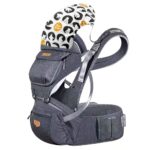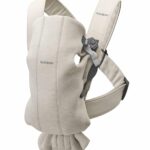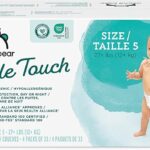Hipseat vs Baby Carrier Which is Best for You and Your Baby? When it comes to carrying your baby, there are many products to choose from. Some are easy to use, while others have straps and instructions that take time to understand. Two popular options are the hipseat and the baby carrier.
Both help you carry your baby safely and comfortably. But they are very different in design and purpose. Let’s explore the key differences and help you decide which is better for you.

Credit : Amazon
Hipseat vs Baby Carrier
What is a Hipseat?
A hipseat is a simple seat you wear around your waist. Your baby sits on it while you support them with one arm. It helps take the baby’s weight off your shoulders and back.
Hipseat Benefits
- Reduces strain: It supports your baby’s weight, saving your back and arms from pain.
- Supports natural posture: It keeps your baby’s legs in an “M” shape, which is good for their hips.
- Easy to use: No complicated straps or setup.
- Great for independence: As babies grow, they can get on and off easily.
Hipseat Limitations
- Not hands-free: You still need one hand to hold your baby.
- Best for older babies: Your baby should have good neck and head control before using a hipseat (around 4-6 months).
What is a Baby Carrier?
A baby carrier is a device that straps your baby close to your chest or back. It allows you to be hands-free while keeping your baby secure.
Benefits of a Baby Carrier
- Hands-free convenience: You can hold your baby and do other tasks at the same time.
- Close bonding: Babies feel safe and calm when held close.
- Good for early months: It mimics the warmth and snug feeling of the womb.
Baby Carrier Limitations
- Can be complex: Some carriers have many straps and can take time to set up.
- Risk of discomfort: Incorrect use may strain your shoulders or neck.
When to Use Each Option
Your choice depends on your baby’s age and your lifestyle.
- Use a hipseat: For quick trips, like shopping or short walks. It’s also great when your baby wants to be held, then put down, and picked up again.
- Use a baby carrier: For hands-free tasks, like cooking, cleaning, or shopping with other kids.

Credit : Amazon
How to Choose Between a Hipseat and a Baby Carrier
Choosing between a hipseat and a baby carrier can feel overwhelming. Both have their strengths, and the best choice depends on your needs and your baby’s preferences. Let’s break it down.
As per Baby’s Age
- Newborns (0-4 months): A baby carrier is the best option. It provides the snug, womb-like comfort they need. Carriers also support their head and neck, which is important at this stage.
- Older Babies (4-6 months and beyond): A hipseat is a great option once your baby can hold their head and neck steady. It’s simpler to use, and your baby will enjoy sitting upright to explore the world.
Consider Your Lifestyle
- Active parents: If you’re often on the move, a hands-free baby carrier is more practical. You can go for walks, do household chores, or run errands while keeping your baby close.
- Quick tasks: A hipseat is ideal for shorter activities. For example, you can use it for a walk in the park, a quick shopping trip, or holding your baby during a family event.
Look at Your Comfort
Carrying a baby can strain your body over time. Consider which option feels better for you.
- Hipseat: It shifts the weight to your hips, reducing strain on your shoulders and back. It’s great for people with back pain.
- Baby Carrier: Some carriers distribute the baby’s weight evenly across your shoulders, back, and hips. However, others may feel heavy after long periods.
Hipseat vs Baby Carrier Comparing Designs
Let’s dive deeper into the features of each.
Hipseat Design
A hipseat is very simple. It consists of:
- A padded seat: Your baby sits on this seat.
- A waist strap: This strap secures the seat around your waist.
- Light padding: Some models include soft padding for extra comfort.
Baby Carrier Design
A baby carrier has a more complex design:
- Shoulder straps: These secure the carrier to your body.
- Back support: Helps distribute your baby’s weight.
- Head and neck support: Protects younger babies.
- Adjustable positions: Some carriers allow front, back, or hip carrying options.
Which is Easier to Use?
- Hipseat: Quick and easy to wear. It’s perfect for parents who don’t want to deal with complicated straps.
- Baby Carrier: It takes some practice to set up. However, once you learn, it becomes a convenient hands-free option.
Safety Tips for Using Both
Your baby’s safety is the top priority. Here are some tips for each option:
Safety of Hipseat
- Secure the strap: Always ensure the waist strap is tight and secure.
- Support your baby: Use one hand to hold your baby, especially during movement.
- Check weight limits: Follow the manufacturer’s guidelines for your baby’s weight and age.
Baby Carrier Safety
- Check your baby’s position: Their head should be close enough to kiss, and their airway should remain clear.
- Use proper adjustments: Tighten straps to keep your baby snug against your body.
- Avoid long periods: Give your baby breaks from the carrier to prevent discomfort.
Hipseat Benefits Combining with Attachments
Did you know some products combine the benefits of both? For example, a hipseat with attachments, like shoulder straps, can give you the convenience of a baby carrier while retaining the simplicity of a hipseat.
Why Use a Combination Product?
- Hands-free option: Attachments allow you to carry your baby securely without using your arms.
- Versatility: You can switch between hands-free and traditional hipseat use.
- Comfort: These products provide better weight distribution, reducing strain on your body.
Features to Look For
- Padded straps: For shoulder comfort.
- Storage pockets: To carry essentials like diapers, bottles, or keys.
- Lightweight design: Easy to carry and use.
Real-Life Scenarios: When to Use Each
Let’s look at some common situations and see which option fits best.
Scenario 1: Running Errands
- Best choice: Baby carrier
- Why: You need your hands free to grab groceries or manage shopping bags.
Scenario 2: Attending a Family Gathering
- Best choice: Hipseat
- Why: Easy to hold your baby while talking to family or moving around.
Scenario 3: Traveling
- Best choice: Baby carrier
- Why: It keeps your baby secure during long walks at the airport or sightseeing trips.
Scenario 4: Short Walk in the Park
- Best choice: Hipseat
- Why: Lightweight and quick to use for short outings.
Pros and Cons of a Hipseat
Pros
- Relieves Back and Shoulder Pain:
A hipseat distributes your baby’s weight to your hips. This reduces strain on your upper body, making it great for people with back pain. - Simple and Easy to Use:
Hipseats don’t have complex straps or instructions. You can strap it on quickly and be ready in seconds. - Encourages Natural Hip Position:
A hipseat supports your baby’s thighs and keeps their knees higher than their bottom. This “M” shape is good for hip development. - Great for On-the-Go Parents:
It’s ideal for short trips where you need to pick your baby up and put them down often. - Doubles as a Feeding Aid:
Some hipseats work as a supportive seat for breastfeeding or bottle-feeding.
Cons
- Not Hands-Free:
You still need one hand to support your baby, which can limit multitasking. - Not Ideal for Newborns:
Hipseats are best for babies with good head and neck control (4-6 months and older). - Limited Usage:
They are great for short activities but may not be comfortable for long periods.

Credit : Amazon
Pros and Cons of a Baby Carrier
Pros
- Hands-Free Convenience:
A baby carrier allows you to carry your baby while keeping your hands free. This makes it perfect for multitasking, like cooking or shopping. - Promotes Bonding:
Holding your baby close fosters a strong emotional connection. Carriers provide skin-to-skin contact, especially useful in the early months. - Supports All Ages:
Many carriers are designed for newborns and older babies, with adjustable features for different stages of growth. - Even Weight Distribution:
A good carrier spreads the weight across your shoulders, back, and hips, making it comfortable for long use. - Multiple Carrying Positions:
Some carriers let you carry your baby on your front, back, or side, giving you flexibility.
Cons
- Can Be Complicated:
Traditional baby carriers often have multiple straps and buckles. It can take time to learn how to use them properly. - Risk of Overheating:
In warm weather, carriers made of thick materials can make your baby and you feel hot. - Strain with Improper Use:
If not adjusted correctly, a carrier may cause shoulder or neck pain over time. - Bulky for Travel:
Some carriers are not compact and can take up space in your diaper bag.
How to Decide Between Hipseat and Baby Carrier
Your decision comes down to what works best for your lifestyle and baby’s needs. Here’s a quick comparison to help you choose:
| Feature | Hipseat | Baby Carrier |
| Age Suitability | 4-6 months and older | Newborn to toddler |
| Ease of Use | Quick and simple | Takes practice to set up |
| Hands-Free? | No | Yes |
| Weight Distribution | Hips-focused | Even across body |
| Ideal For | Short outings, quick tasks | Multitasking, long periods |
| Comfort | Great for short use | Better for extended wear |
Combination Carriers: The Best of Both Worlds
Some brands now offer hybrid products that combine the benefits of hipseats and baby carriers. For example, a hipseat with shoulder straps provides hands-free convenience while keeping the simplicity of a hipseat.
Why Consider a Combination Carrier?
- Versatility: Switch between hands-free and traditional carrying modes.
- Comfort: Offers even better weight distribution.
- Practical Features: Includes storage for essentials, such as diapers or bottles.
Tips for Using Both Safely
For Hipseats:
- Always secure the waist strap tightly.
- Keep one hand on your baby for support.
- Avoid carrying your baby for long periods to prevent strain.
For Baby Carriers:
- Adjust straps properly to prevent discomfort.
- Ensure your baby’s airway is clear at all times.
- Check the carrier’s weight and age limits.
Conclusion
Both hipseats and baby carriers are excellent tools for parents. The right choice depends on your needs, your baby’s age, and your lifestyle.
- Choose a hipseat if you want something quick, simple, and comfortable for short outings. It’s perfect for older babies who enjoy looking around.
- Choose a baby carrier if you need hands-free convenience and plan to carry your baby for longer periods. It’s ideal for newborns and busy parents.
If you can’t decide, consider a combination carrier. These products offer the flexibility of both options, ensuring you and your baby stay comfortable and happy.
No matter what you choose, remember to prioritize safety and comfort for both you and your baby. Babywearing should be a joyful experience that strengthens the bond between you and your little one.







